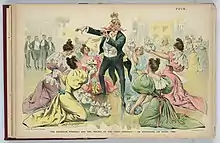The Four Hundred (1892)
The Four Hundred was a list of New York society during the Gilded Age, a group that was led by Caroline Schermerhorn Astor, the “Mrs. Astor”, for many years. After her death, her role in society was filled by three women: Mamie Fish, Theresa Fair Oelrichs, and Alva Belmont,[2] known as the "triumvirate" of American society.[3]
.jpg.webp)
On February 16, 1892, The New York Times published the "official" list of those included in the Four Hundred as dictated by social arbiter Ward McAllister, Mrs. Astor's friend and confidante, in response to lists proffered by others, and after years of clamoring by the Press to know who, exactly, was on the list.[4][5]
History
In the decades following the Civil War, the population of New York City grew almost exponentially, and immigrants and wealthy arrivistes from the Midwest began challenging the dominance of the old New York Establishment.[6] Aided by McAllister, Mrs. Astor[lower-alpha 1] attempted to codify proper behavior and etiquette, as well as determine who was acceptable among the arrivistes,[8] as champions of old money and tradition.[6]
Reportedly, Ward McAllister coined the phrase "The Four Hundred" by declaring that there were "only 400 people in fashionable New York Society."[9] According to him, this was the number of people in New York who really mattered; the people who felt at ease in the ballrooms of high society.[10] In 1888, McAllister told the New-York Tribune that "If you go outside that number," he warned, "you strike people who are either not at ease in a ballroom or else make other people not at ease."[11]
While the number four hundred has popularly been linked to the capacity of Mrs. Astor's ballroom at her large brownstone home at 350 Fifth Avenue and East 34th Street (today the site of the Empire State Building),[12][13] the exact origins remain unknown.[14] There were, however, other lists in New York around the same time which necessitated a maximum capacity of four hundred, including Delmonico's restaurant and local cotillion dances, that may have contributed to the particular sum of four hundred.[15]
February 1892 list
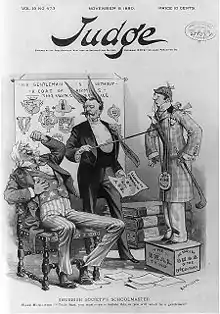
In response to competing lists naming the purported members of New York society published in the New York World that insisted New York society was, in fact, made up of only 150 people,[16] McAllister spoke with The Times, refuting the World article and giving the paper the "official list", which was published on February 16, 1892 and quoted McAllister stating:
“The so-called Four Hundred has not been cut down or dwindled to 150 names. The nonsense, don't you know, printed to that effect in the World and some other papers, has made a very bad impression that will reflect badly against them, you understand. That list of names, you understand, printed on Sunday, did not come from me, don't you see. It is unauthorized, don't you see. But it is accurate as far as it goes, you understand.
It is incomplete and does injustice, you understand, to many eligible millionaires. Think of leaving out such names, don't you know, as Chauncey M. Depew, Gen. Alexander S. Webb, Mr. and Mrs. Edward Cooper, Mr. and Mrs. Luther Kountze, Mr. and Mrs. Robert Goelet, Mr. and Miss Wilson, Miss Greene, and many others! Don't you understand, it is absurd, senseless.
Let me explain, don't you know. There are three dinner dances, don't you know, during the season, and the invitations, don't you see, are issued to different ladies and gentlemen each time, do you understand? So at each dinner dance, you know, are only 150 people of the highest set, don't you know. So, during the season, you see, 400 different invitations are issued.
Wait a moment and I will give you a correct list, don't you know, of the people who form what is known as the Four Hundred. Do you understand it will be authorized, reliable, and, don’t you know, the only correct list.”[4]
The list, purported to include the crème de la crème of New York society, consisted largely of "bankers, lawyers, brokers, real estate men, and railroaders, with one editor (Paul Dana of The New York Sun), one publisher, one artist, and two architects."[7] It also included a mix of both "Nobs" and "Swells".[17] "Nobs" came from old money (including the Astors, the Goelets, the Livingstons, and the Van Rensselaers), and "Swells" were representatives of the nouveau riche, who Mrs. Astor felt, begrudgingly, were able to partake in polite society (best personified by the Vanderbilt family).[17]
Criticism and backlash
After McAllister released the names of The Four Hundred in The New York Times, there was significant backlash, both against the idea of a definitive list of "acceptable society" and McAllister himself.[18][19] The papers dubbed him "Mr. Make-a-Lister" and, in combination with his memoirs published in 1890, entitled Society as I Have Found It,[20] further ostracized him from the "old guard", who valued their privacy in an era when the leaders of society were the equivalent of modern movie stars.[15] William d'Alton Mann, who owned the Town Topics, a gossip magazine, considered it his duty to expose the sins of society and regularly criticized the Four Hundred.[19]
Several years later, author O. Henry released a collection of short stories, entitled The Four Million, a reaction to this phrase, expressing O. Henry's opinion that every human being in New York was worthy of notice.[21]
In 2009, the Museum of the City of New York compiled its own list, entitled “The New York City 400,” of the 400 "movers and shakers" who made a difference in the 400 years of New York City history since Henry Hudson arrived in 1609. McAllister was "the only person on the original Four Hundred to also make the museum’s list."[22]
Named members of "The Four Hundred"
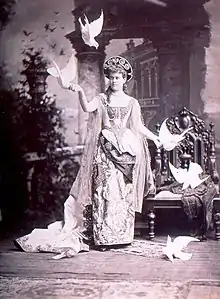

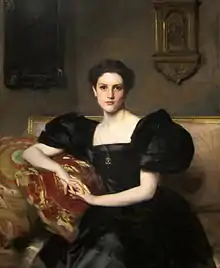
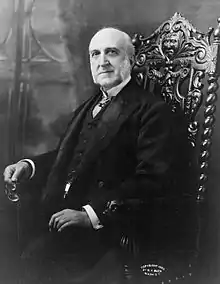

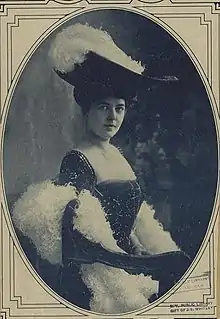
_(cropped).jpg.webp)

.jpg.webp)

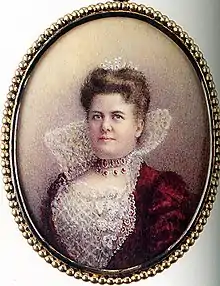
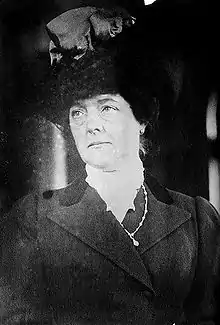
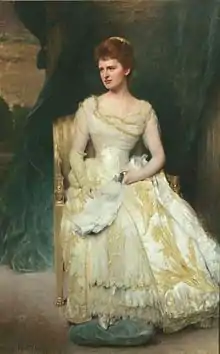
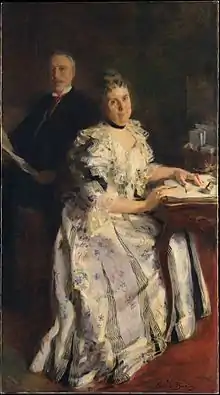
.jpg.webp)
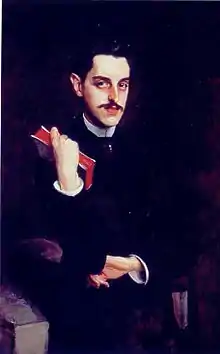
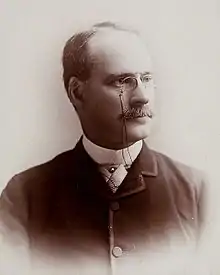
Besides containing far fewer than 400 people, McAllister's list "abounded in inaccuracies: names were misspelled or incomplete and many spouses omitted or, worse, included although they were dead."[23] The rules of the time dictated that "only the eldest unmarried daughter of a family carried the title "Miss," with no given name," but he regularly ignored the rule.[23]
References
- Notes
- McAllister called Mrs. Astor "the Mystic Rose," referring to the "figure in Dante's Paradise around whom all in Paradise revolve,"[7]
- John Jacob Astor IV was Mrs. Astor's only son. Astor and his second wife, Madeleine Astor, were on the maiden voyage of the RMS Titanic. Astor, the richest passenger onboard, died during the sinking of RMS Titanic on April 15, 1912.[24]
- Elizabeth Cavendish-Bentinck, a member of the Livingston family, was included, but her husband, MP William George Cavendish-Bentinck was not. William was a grand-nephew of the 4th Duke of Portland and great-grandson of the 3rd Duke of Portland, the Prime Minister of United Kingdom under George III.[25]
- Sources
- "Mrs. William Astor (Caroline Webster Schermerhorn, 1831-1908)". www.metmuseum.org. Metropolitan Museum of Art. Retrieved 3 February 2019.
- MacColl, Gail; Wallace, Carol McD (2012). To Marry an English Lord: Tales of Wealth and Marriage, Sex and Snobbery in the Gilded Age. Workman Publishing. ISBN 9780761171980. Retrieved 3 February 2019.
- Columbia, David Patrick (30 August 2007). "The Adventures of Tessie". New York Social Diary. Retrieved 10 September 2018.
- McAllister, Ward (16 February 1892). "THE ONLY FOUR HUNDRED | WARD M'ALLISTER GIVES OUT THE OFFICIAL LIST. HERE ARE THE NAMES, DON'T YOU KNOW, ON THE AUTHORITY OF THEIR GREAT LEADER, YOU UNDER- STAND, AND THEREFORE GENUINE, YOU SEE" (PDF). The New York Times. Retrieved 26 March 2017.
- Burrows, Edwin G.; Wallace, Mike (1998). Gotham: A History of New York City to 1898. Oxford University Press. p. 1072. ISBN 9780199729104. Retrieved 3 February 2019.
- "Vanderbilt Ball – how a costume ball changed New York elite society". MCNY Blog: New York Stories. 2013-08-06. Retrieved 2016-11-12.
- Bryk, William (August 9, 2005). "The Father of the Four Hundred". The New York Sun. Retrieved 3 February 2019.
- Gavan, Terrence (1988). The Barons of Newport: A Guide to the Gilded Age. Newport, Rhode Island: Pineapple Publications. p. 27. ISBN 9780929249018. Retrieved 3 February 2019.
- Salvini, Emil R. (2005). Hobey Baker: American Legend. Hobey Baker Memorial Foundation. p. 3. ISBN 9780976345305. Retrieved February 27, 2018.
- Crain, Esther (2016). The Gilded Age in New York, 1870-1910. Running Press. p. 135. ISBN 9780316353687. Retrieved 3 February 2019.
- Somers, Reneé (2013). Edith Wharton as Spatial Activist and Analyst. Routledge. p. 27. ISBN 9781135922979. Retrieved 3 February 2019.
- Keister, Lisa A. (2005). Getting Rich: America's New Rich and How They Got That Way. Cambridge University Press. p. 36. ISBN 9780521536677. Retrieved 20 October 2017.
- Parker, Maggie. "The Four Hundred: Then and Now Tony Abrams has reinvented Gilded Age society. Will you get in?". Dujour. Retrieved September 22, 2018.
- Grimes, William (2009). Appetite City: A Culinary History of New York. Farrar, Straus and Giroux. p. 102. ISBN 9781429990271. Retrieved 3 February 2019.
- Columbia, David Patrick (18 August 2011). "The First Four Hundred". New York Social Diary. Retrieved 1 March 2018.
- "THE GILT-EDGED 150, Society Leaders Make Fun of McAllister's Roster. | Sarcastic Comments by Mrs. Fish and Mrs. Whitney. | He is Not Society's Arbiter, and Society Accepts No Responsibility for His Acts". The Evening World. February 17, 1892. p. 1. Retrieved 13 February 2019.
- Haden-Guest, Anthony (25 July 2015). "The 400 Hottest New Yorkers…of 1892". The Daily Beast. Retrieved 3 February 2019.
- Torgerson, Rachel (May 15, 2015). "What Was it Like to Attend One of Mrs. Astor's Gilded Age Parties in NYC?". Gotham. Retrieved 3 February 2019.
- Holland, Evangeline (April 6, 2009). "The Four Hundred". Edwardian Promenade. Retrieved 3 February 2019.
- Ward McAllister (1890) Society as I Have Found It, Cassell, New York
- "WARD M'ALLISTER DEAD; He Had Been Ill for a Week with an Attack of the Grip. THE END WAS UNEXPECTED His Condition Not Considered Serious by His Physicians Until Wednesday Morning -- His Long Career as a Society Leader" (PDF). The New York Times. 1 February 1895. Retrieved 21 October 2017.
- Roberts, Sam (8 September 2009). "400 Years and 400 Names: Museum Tweaks City A-List". The New York Times. Retrieved 3 February 2019.
- Patterson, Jerry E. (2000). The First Four Hundred: Mrs. Astor's New York in the Gilded Age. Random House Incorporated. pp. 207–234. ISBN 9780847822089. Retrieved 3 February 2019.
- "Noted Men On The Lost Titanic. Col. Jacob Astor, with His Wife. Isidor Straus and Wife, and Benj. Guggenheim Aboard" (PDF). The New York Times. April 16, 1912. Retrieved 2013-12-10.
Following are sketches of a few of the well-known persons among the 1,300 passengers on the lost Titanic. The fate of most of them at this time is, of course, not known. Col. John Jacob Astor and Mrs. Astor, Isidor Straus and Mrs. Straus, J. Bruce Ismay, Managing Director of the White Star Line: Benjamin Guggenheim, and Frank D. Millet, the artist, are perhaps the most widely known of the passengers. ... .
- Times, Special Cable To The New York (23 August 1909). "G. CAVENDISH-BENTINCK DEAD | Wife Was Elizabeth Livingston, Sister of Mrs. Ogden Mills" (PDF). The New York Times. Retrieved 24 February 2017.
External links
- Patterson, Jerry E. The First Four Hundred: Mrs. Astor's New York in the Gilded Age, Rizzoli, New York (2000) ISBN 0847822850
